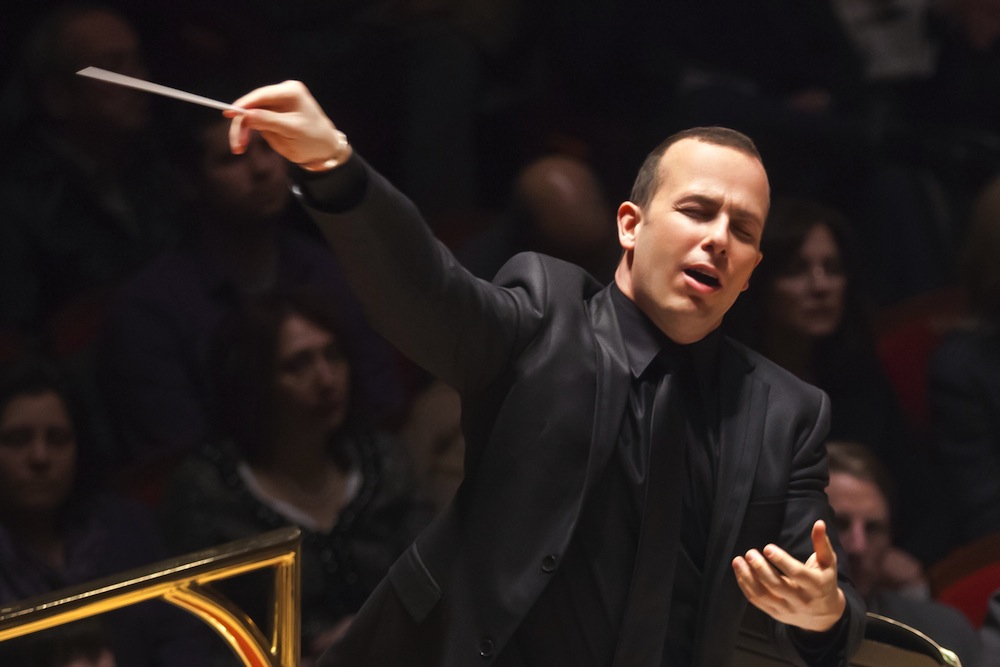Philadelphia Orchestra joshes with Haydn, then scales the heights with Bruckner

Yannick Nézet-Séguin conducted the Philadelphia Orchestra in Haydn and Bruckner Tuesday night at Carnegie Hall. File photo: Chris Lee
Carnegie Hall announced its 2016–17 season Tuesday morning, which will feature several visits from the Philadelphia Orchestra under conductor Yannick Nézet-Séguin.
Later that evening the musicians played Haydn’s Symphony No. 103 and Bruckner’s Symphony No. 4, in a concert that was a reminder of how welcome their visits have become.
The first half was genial, like a social event. That feeling was inaugurated by a modest bit of stagecraft; while the applause that greeted Nézet-Séguin was still sounding, the drum roll began. The conductor whirled on the podium, play-acted being startled, and the symphony was off.
Or rather, it began. The opening tempo is Adagio, and the overall feel of the performance of the full work was relaxed. There was no exploration of the formal tension and release in the symphony, and the rhythms tended to be as legato as the phrases.
At the same time, the orchestra’s matte red-cherry sound was a pleasure in and of itself, and the conviviality of the playing, the sense that audience and musicians were enjoying each other’s company, was winning.
The details added to the feeling of a social event. The opening drum roll was played at a crisp, surprising fortissimo, and timpanist Don S. Liuzzi gave it a nice sense of roughness and freedom. Concertmaster David Kim played his second movement solo in a bright fiddle style, and both soloist and orchestra responded to each other with a subtle and playful rubato. The Haydn warmed everyone up.
The Bruckner, on the other hand, was played with deep involvement and energy. This is one of the finest works from the great symphonist, and Nézet-Séguin and the orchestra played the Fourth Symphony superbly, with the relish of musicians who know they are working with great music.
While the opening string tremolo had a quiet but palpable presence, principal horn Jennifer Montone’s introductory solo didn’t quite convey the right sense of distance, though her playing was lovely.
That was the only misstep, and a minor one. The long arch of the symphony was beautifully laid out, and the inner workings—Bruckner’s collection of grand gestures, plangent melodies, dimension-shifting modulations, and pounding rhythms—were connected in a smooth, horizontal flow that is not commonly heard in his music. Nézet-Séguin built the cathedral-like vertical dimensions of the orchestral sound in a way that felt like the great organist Bruckner himself would have. There was the sense of stops being added, one by one, the musicians themselves in no hurry as the pulse itself carried everything along.
The opening tempo was relaxed, but the first movement built inevitably to a forceful minor key recapitulation of the opening themes. Nézet-Séguin boosted the tempo subtly at the coda, which filled the hall and shook the floor, and then dispensed with a cut-off and let the final chord ring out.
In the Andante, the viola section played their lead melody with a gorgeously dark, throaty sound and tremendous musicality. the conductor’s handling of the alternating sense of time in the music, rocking back and forth between stasis and forward motion, was impressive.
The third movement was brisk and explosive, and the pulse in the trio section marvelously flowing, and glowing with energy. In the final movement, Nézet-Séguin added biting rhythmic tension to the overall momentum that had been building since the opening bars. Like an object in space, the orchestra built expressive and musical mass as it expressed greater and greater energy. There was a compelling, veiled tension in the coda that made a context for and contrast with the ringing final chord.
The orchestra’s sound throughout the Bruckner was exceptional. Every section had a presence, and cooperated with every other—the brass in particular seemed perfectly balanced. More than a homogenized sound, though, individual sections and instruments spoke with character, a spike of color here, a touch of rubato there. This was not just great Bruckner playing, but great ensemble music-making.
The Philadelphia Orchestra returns to Carnegie Hall May 11, playing Rachmaninoff’s Piano Concerto No. 1, with Lang Lang, and Deryck Cooke’s edition of Mahler’s Symphony No. 10 carnegiehall.org







Posted Jan 27, 2016 at 5:40 pm by Sylvia Alimena
Given that the extraordinary Principal Hornist, Ms. Montone is no stranger to pianissimo, it is very possible that Maestro specifically asked for the marking of mezzo forte which Bruckner writes in the score. In this case, it might sound less like an apparition and more like a calling out into the valley. Regardless, the opening is often played very softly but not always. I wouldn’t call that a misstep but rather an interpretation of what Bruckner wrote ( along with some rather explicit but somewhat subjective German terminology to go along with that marking).